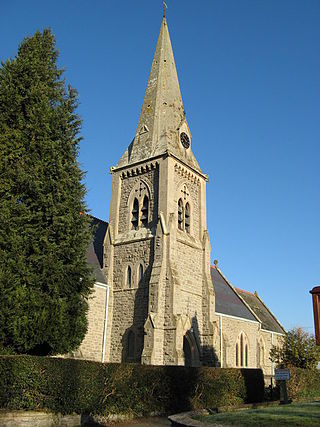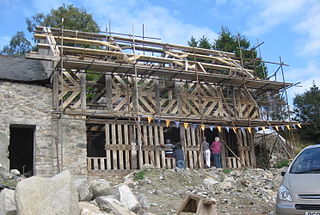Related Research Articles

Welshpool is a market town and community in Powys, Wales, historically in the county of Montgomeryshire. The town is four miles from the Wales–England border and low-lying on the River Severn. The community, which also includes Cloddiau and Pool Quay, has a population of 6,664, with the town having 5,948. There are many examples of Georgian architecture within the town. Powis Castle is located to the north.

Meifod, formerly also written Meivod, is a small village, community and electoral ward seven miles (11 km) north-west of Welshpool in Montgomeryshire, Powys, Wales, on the A495 road and located in the valley of the River Vyrnwy. The River Banwy has a confluence with the Vyrnwy approximately two miles (3.2 km) to the west of the village. The village itself had a population of 317. The community includes the village of Bwlch-y-cibau and the hamlet of Allt-y-Main.

Pontrobert is an ecclesiastical parish that was formed in September 1854. It comprises the townships of Teirtref and part of Nantymeichiaid in the parish Meifod, a portion of Cynhinfa which was in the parish of Llangynyw and portions of the townships of Fachwel, Llaethbwlch and Cadwnfa which were in the parish of Llanfihangel. The total area of this parish is 5,000 acres. As a result of this arrangement, Pont Robert is now divided between the present day Community Councils of Meifod, Llangyniew and Mawddwy. Pontrobert was within the historic county of Montgomeryshire, now forming part of Powys. The name Pontrobert is derived from Robert ap Oliver of Cyhinfa, who built the original bridge over the River Vyrnwy around 1700. An alternative Welsh name for Pontrobert is Pont y ddolfeiniog.
Kerry is a village and geographically large community in Montgomeryshire, Powys, Wales.

The Abbey of Strata Marcella was a medieval Cistercian monastery situated at Ystrad Marchell on the west bank of the River Severn near Welshpool, Powys, Wales.

Llanwddyn is a village and community in Montgomeryshire, Powys, Wales. The community is centred on the Lake Vyrnwy reservoir. The original Llanwddyn village, about 2 miles (3.2 km) northwest, was submerged when the reservoir was created in the 1880s.
Margaret Sidney Davies, was a Welsh art collector and patron of the arts. With her sister Gwendoline, she bequeathed a total of 260 works, particularly strong in Impressionist and 20th-century art, which formed the basis of the present-day National Museum Wales' international collection. The sisters started the Gregynog Press in 1922 and the Gregynog Music Festival in 1933.
John Davies Knatchbull Lloyd OBE, generally known as J. D. K. Lloyd or The Widow Lloyd, was an antiquarian researcher, public servant and notable figure in the memoirs of many of the notable figures of the twentieth century, including Evelyn Waugh and Anthony Powell.

Leighton Hall is an estate located to the east of Welshpool in the historic county of Montgomeryshire, now Powys, in Wales. Leighton Hall is a listed grade I property. It is located on the opposite side of the valley of the river Severn to Powis Castle. The Leighton Hall Estate is particularly notable for the hall which was decorated and furnished by the Craces to designs by Pugin in his Houses of Parliament style, for the Home Farm, a model farm, which was to be in the forefront of the Victorian industrialised High Farming, and for the gardens which have their own Grade I listing on the Cadw/ICOMOS Register of Parks and Gardens of Special Historic Interest in Wales. Leighton Hall was also the birthplace of the much disparaged hybrid Cupressocyparis leylandii hedge tree. The hall is in private ownership and is not accessible to the public, although it can still be viewed from the road. The home farm is currently under restoration.
Montgomeryshire Collections is the annual journal of the Powysland Club, containing scholarly articles on archaeological and historical topics relating to Powys, book reviews, and society notes. It was first published under the title Collections Historical & Archaeological relating to Montgomeryshire, 1868 – 1942 ; it then changed its name to Montgomeryshire Collections: relating to Montgomeryshire and its borders, 1943 – present.
David Pugh was a wealthy tea trader, a Welsh landowner and Conservative Party politician who sat in the House of Commons in 1832, and again between 1847 and 1861.

Llandyssil is a village in the community of Abermule with Llandyssil, in Powys, Wales, in the traditional county of Montgomeryshire. It is about two miles from the town of Montgomery.

John Thomas was a Welsh photographer, specialising in landscape images of Wales and Welsh chapels, and portraits of notable Welsh people, particularly church and chapel ministers.
Poundley and Walker or John Wilkes Poundley and David Walker were a land surveyors and architects’ partnership with offices at Black Hall, Kerry, Montgomeryshire and at Unity Buildings, 22 Lord Street, Liverpool. The partnership was established probably in the mid-1850s and was dissolved in June 1867. The partnership was involved with large country estate building projects, church and civic buildings and some civil engineering. They specialized in building model farms. J. W. Poundley was also the county surveyor for Montgomeryshire from 1861–1872. The architect, canal and railway engineer, T. G. Newnham appears have been associated with the partnership.

James Kellaway Colling (1816–1905) or J. K. Colling was an English architect, watercolour artist and noted book illustrator. He was a pioneer of early Chromolithographic printing and his graphic work has been compared with that of William Morris and John Ruskin
Willans may mean:

Glas Hirfryn is a farm in Cwmdu, at east side of the road through the valley of the Lleiriog on the southern side of the Berwyn Mountains. It is in the community of Llansilin, which was formerly in Denbighshire, but since 1996 has been in the Montgomeryshire part of Powys. The timber-framed farmhouse, which stands within a group of farm buildings was abandoned in the mid-20th century, at which time it was listed as Grade II. The house has now been dated by dendrochronology to about 1559 AD or shortly afterwards.
James Walton was a British inventor and industrialist. He was known for the significant improvements he made to the carding process. He amassed a considerable fortune from his business ventures, and purchased two large family estates in Wales.
John William Willans (c.1843-1895) was a British mechanical and electrical engineer, most known for his role as Chief Engineer of the Liverpool Overhead Railway.
Dolforgan Hall is a large manor house near Kerry, Powys.
References
- 1 2 3 4 5 6 "WILLANS, JOHN BANCROFT (1881 - 1957), country landowner, antiquarian and philanthropist". Dictionary of Welsh Biography. The National Library of Wales. 2001.
- 1 2 3 "Hidden photos donated to library". BBC News. 21 January 2005.
- ↑ Armstrong, Patrick H.; Martin, Geoffrey (14 December 2015). Geographers: Biobibliographical Studies. Vol. 25. Bloomsbury Publishing. p. 29. ISBN 9781474227025.
{{cite book}}:|work=ignored (help)